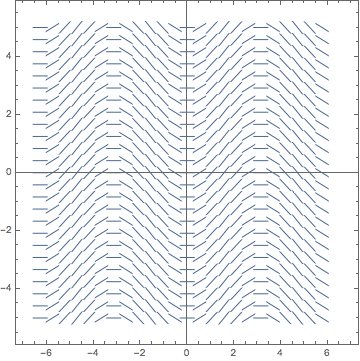Slope Fields with Mathematica - Exercise 1.2
Making Slope Fields by Yourself
A Post Exercise Discussion of
dy/dx = sin x, on the region -2π ≤ x ≤ 2π, and -5 ≤ y ≤ 5
Once again, I hope you actually did do the exercise in Mathematica before you came here to see the discussion. If you didn't do it yet , go back and do the exercise now!
Assuming that you did the exercise correctly, you should have produced a picture that was very much like the following:

Here too, you should have noticed that the isoclines for this slope field are vertical lines, (just like the last example.) Do you recognize the general trend of the field this time? It's harder to see than the one with the parabolas, but if you really think about it, those little waves should look a bit familiar. Hmmm, symmetry about the y-axis, like the cosine function, but upside down. That would make it the negative of the cosine function, wouldn't it? A whole family of them shifted vertically from one another!
Again, this makes sense if you think about solving this differential equation using integration. If you simply integrated:
You'd get:
This would make a whole family of upside down cosine functions, depending upon what value you give to the constant C, which would match what the slope field is telling us too. Are you starting to make the connection between slope fields and analytic solutions?
That's the end of my discussion—let's go back to the exercises.







